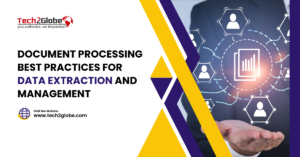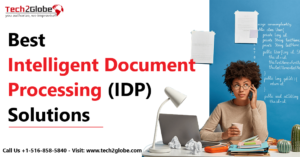The act of handing over responsibility for a company’s document-intensive tasks to a professional or outside party is known as outsourcing document processing. The process of converting handwritten, typed, or digitized text and images from paper-based or electronic files into a digital format is known as document processing. Usually, the digitized photographs and recorded data are entered into an electronic document management system (EDMS). The service provider may make use of knowledgeable data entry services staff as well as various document processing services systems, such as Intelligent Character Recognition (ICR) and Optical Character Recognition, for conversion. The majority of business operations, including procurement, accounting, and corporate strategy, heavily rely on documentation.
What More in Outsource Document Processing?
Examples of frequently outsource document processing services include methods of collecting information, document searching, document indexing and linking, data capture, data encryption, records conversion and retention, recordkeeping, document procedure or workflow engineering, help desk, disaster recovery, integration with legacy applications, and cloud-based secure file access.
Businesses outsource document processing company largely to reduce costs, improve process effectiveness, promote innovation, and add value, according to a survey. Due to their access to technology, expertise in their respective fields, and comprehensive understanding of customer needs, service providers may provide high levels of efficiency at low costs.
Check The List!
1. Industry Size And Forecast
According to the Global Document Outsourcing Market 2014-2018 research covering the Americas, APAC, and EMEA regions, the industry will develop at a compound annual growth rate (CAGR) of 5.25 percent from 2013 to 2018. The increase in enterprises seeking end-to-end document process outsourcing is fueling growth. Although services offered by data conversion services are expanding, their growth may be constrained by strict service level agreements, it was stated.
2. The Growth Of The Industry Of Outsourced Document Processing
In the early 1990s, while BPO contracts were still in their infancy, outsource document processing companies saw opportunities to offer document-intensive services as standalone agreements or in collaboration with big BPO providers. Outsourced document processing services is now expanding as a result of the demand from organizations looking for end-to-end document processing solutions. DPO is becoming understood as a strategic solution that improves business process effectiveness and generates value as opposed to just being a tool for cost-cutting. Document Processing Services is still growing in popularity, and more service providers are expanding their product offerings to offer services other than regular document processing. In contrast to conventional document processing, Document Processing service provider of today fulfill each step.
3. Outsourced Document Processing Trends
Outsource document processing is more than just a technique to save money in the twenty-first century. According to a Forbes Insights survey, more companies are using metrics that consider elements other than bottom-line savings. Although reducing costs remains the top concern, organizations are also looking for new ways to improve operations and produce long-term value. Businesses looking to hire external professionals Outsource Data Conversion Services desire value-added advantages like higher productivity, improved client relations, and additional revenue streams. Document Processing Services USA are responding by expanding their product lineups to meet demand. Here is how a Outsource Document Processing vendor helped a rental car company cut costs and boost productivity by taking care of the administration and rearranging the client’s internal document process.
4. Intelligent Character Recognition
The most effective optical character recognition (OCR) method for digitizing texts with different handwriting styles is one that is more narrowly focused. To recognize any character in a scanned image, document processing uses ICR software. When the ICR application returns this information, the machine and the end user may recognize it. A high-resolution digital image of the document is given to the computer after being scanned. ICR software analyses the image and transforms the data into machine-readable characters. The modern ICR software’s neural network (self-learning) design frequently updates the recognition database.
5. Processing Forms Using ICR
used to read the forms and manually enter the data into a computer to process forms. When automated forms processing was first introduced in 1993, it involved three steps: scanning the source document, preparing it for image character recognition (ICR), entering the data, and processing the output for automatic validation. Today, businesses automate this procedure and attain an accuracy of about 98 percent, comparable to that of Offline data entry, using scanners and ICR/OCR form processing software. ICR, optical character recognition (OCR), and optical mark recognition (OMR) systems are frequently combined in forms processing software to digitize handwritten text, machine-printed type, marks on checkboxes, bar codes, and signatures from scanned pictures.
6. Making Use Of Optical Character Recognition (OCR)
By converting scanned text images into a format that computers can easily recognize, alter, search for, store, and display. Optical character recognition systems are often used in document processing to transform data from paper-based and digital records into machine-encoded text. OCR is used by businesses to encrypt massive volumes of data, reduce their paper trail, eliminate mistakes in data entry, condense Outsource Data Entry Services, and produce text that is readable by people. OCR input (original document) sources include printed material (passports, invoices, business cards), handwritten text (prescription lists, snail-mail chats), and scanned images, including written material and handwriting. A specified file format, such as PDF, is used to transmit and save the result.
6. OCR Approach
It is common practice to scan original documents before converting them to digital format. The data is then archived in a variety of digital formats and made available on the internet. Two main categories of print items are digitized using a variety of techniques by archivists and best data entry services professionals. Examples of printed materials with graphics include drawings, manuscripts, slides, posters, antique pictures, and printed items with illustrations or images. Many old and historical documents are thought to be graphic-based due to their frequent use of unusual fonts, stains, and colorful backgrounds.
Conclusion
Choose Tech2globe for document processing services, and excerpts here will help you with the ebay of the services at the right time.










